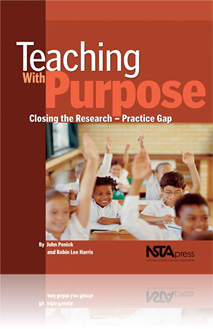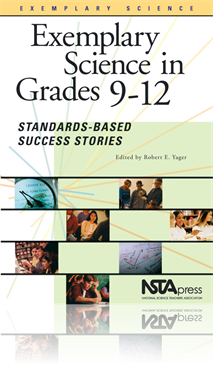All Book Chapters
Book Chapter
Developing a Research–Based Rationale
Developing a research-based rationale requires formulating a way of thinking about teaching. Rather than a casual, weekend effort, the creation of a complete rationale is a long-term enterprise that may last for years and may never be finished (and p...
Book Chapter
Implementing Your Rationale and Becoming a Mentor
In this chapter, the authors discuss how you can implement your rationale in the classroom and use it to become a mentor to others. As you develop and implement research-based rationale for teaching, you will find yourself changing—teaching and com...
Book Chapter
It's the "Little Things" That Can Change the Way You Teach
The "Little Things" project is a unique curriculum on the soil ecology of microbes that offers students an opportunity to engage in real science research, develop an understanding of the biochemistry of soil microbes and to cultivate in students, an ...
Book Chapter
Sing and Dance Your Way to Science Success
The research in this chapter was conducted at Independence High School in Charlotte, North Carolina to determine whether creating a different kind of classroom learning environment could help at-risk students achieve success in biology. The research ...
Book Chapter
Student Inquiry at the Illinois Mathematics and Science Academy
This chapter features the Student Inquiry Program at the Illinois Mathematics and Science Academy (IMSA)—an internationally recognized, pioneering educational institution created by the State to develop talent and stimulate excellence in teaching a...
Book Chapter
Teacher Action Research on Interactive Lectures: Engaging All Students in Verbal Give-and-Take
Amherst Regional High School is a public school located within a five-college community in western Massachusetts. Most of the work outlined in this chapter springs from a course on Collaborative action research (Car). Conducting action research allow...
Book Chapter
Stop Talking, Start Listening: Turning Didactic Science Teaching on Its Head
In this chapter, the authors hope to illustrate science instruction that focuses on real-world problems and features the science teacher performing a variety of research-based strategies during any given teaching segment. It is a major goal also of t...
Book Chapter
The Sky's the Limit: A More Emphasis Approach to the Study of Meteorology
This chapter features curriculum for the senior Meteorology elective at the Marymount School of New York—an all-female, independent school in New York City. The curriculum is aligned with the National Science Education Standards (NSES) More Emphasi...
Book Chapter
The author—a teacher at Rockwall High School in Texas—covers specific standards in this chapter which includes selecting and adapting curriculum, as well as guiding students in active and extended scientific inquiry. The course is intended to mak...
Book Chapter
Successes and Continuing Challenges: Meeting the NSES Visions for Improving Science in High Schools
The 15 programs described in this book illustrate where we are with respect to realizing the vision of the 1996 National Science Education Standards (NSES)—eight years after their publication and acceptance as needed new directions. The hope and ex...
Book Chapter
Technology and Cooperative Learning: The IIT Model for Teaching Authentic Chemistry Curriculum
Computer technology emerged as a viable tool for classroom instruction. This chapter reflects upon a case study of a high school chemistry classroom where the computer was used in a unique way to deliver and direct curriculum on acids and bases. The...
Book Chapter
Inquiring Minds Want to Know All About Detergent Enzymes
This enzyme unit demonstrates how students can learn using inquiry and questioning techniques. By providing students the opportunity to share ideas, evaluate problem statements, develop hypotheses, design experiments, and make conclusions, they acqui...
Book Chapter
Teaching Ecology by Evolving and Revolving
This chapter features an ecology course started by Harry Hitchcock at Clinton High School (CHS) in Clinton, Tennessee, in response to a need for more elective courses in science. This ecology class is a hands-on course that engages students in person...
Book Chapter
The program highlighted in this chapter—the Biomedical Engineering Challenge-Based Curriculum—features science curricula that meet numerous More Emphasis standards through the use of challenged-based “Legacy Cycle” materials. Challenges are b...
Book Chapter
RIP-ing Away Barriers to Science Education: Inquiry Through the Research Investigation Process
This chapter presents the Research Investigation Process (RIP), an "inquiry" and "critical thinking" model of science education at two high schools—the Academy for the Advancement of Science and Technology (AAST) and Halau Lokahi Public Charter Sch...



